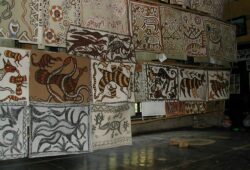Textured Artworks, a World of Tactile Creativity
 Posted On
Posted On
Texture in art refers to the perceived surface quality of a piece. It can be created through a variety of methods, including layering materials, applying thick paint, incorporating mixed media elements, or even carving into a surface.
Art has always been a means of expressing ideas, emotions, and experiences. From the delicate strokes of a paintbrush to the precise lines of a pen, artists have utilized various techniques to bring their visions to life. One such technique that adds depth and dimension to artworks is texture. Textured artworks engage our sense of touch, offering a unique sensory experience that goes beyond the visual realm. In this article, we will delve into the fascinating world of textured art and explore its significance in the realm of creativity.
Texture in art refers to the perceived surface quality of a piece. It can be created through a variety of methods, including layering materials, applying thick paint, incorporating mixed media elements, or even carving into a surface. By adding texture, artists provide viewers with an additional sensory channel to engage with their work. The tactile experience offered by textured art creates a richer and more immersive encounter, inviting viewers to explore the artwork through touch.
One of the most iconic examples of textured art is Vincent van Gogh’s paintings. His masterpieces, such as “Starry Night” and “Sunflowers,” showcase his distinctive brushwork, with thick, impasto layers of paint that create a palpable texture on the canvas. Van Gogh’s use of texture not only adds a visual interest but also conveys the artist’s emotions and energy. The raised brushstrokes capture the intensity of his artistic process, making his works come alive with a dynamic and tangible quality.
Beyond traditional paintings, artists have ventured into experimental forms of texture by incorporating unconventional materials. Mixed media artworks, for instance, often feature a combination of materials like fabric, paper, wood, metal, and found objects. By juxtaposing different textures, artists create an intricate interplay of surfaces, inviting viewers to experience the contrasts and connections within the artwork.
Sculpture is another domain where texture takes centre stage. From the smooth marble sculptures of ancient Greece to the rugged surfaces of contemporary installations, sculptors have used texture to evoke specific sensations and narratives. The rough texture of stone or the smoothness of polished metal elicits different emotional responses, as viewers are compelled to touch the artwork and explore its physical contours.
Textured art is not limited to traditional mediums. Digital artists have also embraced the concept, employing technology to simulate tactile experiences. By utilizing software and specialized tools, they can replicate the appearance and feel of various textures, opening up new avenues for exploration and creative expression.
The significance of texture in art extends beyond aesthetics and sensory pleasure. It serves as a powerful tool for storytelling and communication. Artists often use texture to convey narratives, symbolize ideas, or evoke certain moods. For example, rough and jagged textures might represent conflict or turmoil, while smooth and flowing textures could convey a sense of tranquillity or harmony. By manipulating texture, artists can guide viewers’ interpretations and create deeper connections between the artwork and its audience.
Moreover, textured art has practical applications beyond the realm of aesthetics. In art therapy, for instance, the tactile experience of creating textured artworks can be therapeutic and healing. Engaging with different materials and textures allows individuals to express and process their emotions, fostering self-discovery and personal growth.
In conclusion, textured artworks provide a multisensory experience, inviting viewers to engage with art beyond the visual realm. Through the use of various techniques and materials, artists create tactile surfaces that captivate our sense of touch and amplify our emotional response. Texture adds depth, complexity, and narrative to art, expanding the possibilities of creative expression. So, the next time you encounter a textured artwork, don’t hesitate to reach out and explore the artist’s world through your fingertips.



